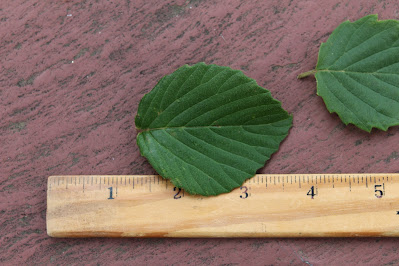 |
| The arrowwood shrubs are extra special this week because of the clusters of pretty flowers. |
 |
| The arboretum sign marks an arrowwood shrub. Rather than one thick trunk, we see four stems, and all four stems have some age on them―the bark is mature; rough and peeling. |
 |
| Viburnum dentatum, mature bark |
 |
| Viburnum dentatum, mature bark |
 |
| This photo shows that pruning has been necessary. |
 |
| In the first half of May, we are seeing bunches of beautiful white flowers. |
 |
| The flowers are numerous and pleasing to view, but they do not have a pleasant fragrance. |
 |
| Viburnum dentatum, flowers and leaves |
 |
| Viburnum dentatum, flower cluster |
 |
| Two twigs were snipped for inspection. An inflorescence appears at the tip of one twig. Leaves are a dark, rich green, with dentate margins. Twigs and leaves are fuzzy! |
 |
| Underneath, leaves are lighter green, and we see that the leaves are opposite. |
 |
| This inflorescence measures approximately 2 inches across. Flowers are tiny. |
 |
| This leaf has an ovate shape and measures approximately 2½ inches in length. The toothed margins aren't as noticeable in this picture. |
 |
| This leaf is in the shape of a circle and measures 1¾ inches across. |
 |
| This leaf is heart-shaped and measures 2¼ inches across. The dentate margins are very noticeable in this photo. |
 |
| Viburnum dentatum, variable leaf shape but all are fuzzy |
 |
| For quite some time, at minimum 10 years, a dewberry patch (Rubus trivialis) has thrived under the protection of this grouping of arrowwood. Annually, it produced handfuls of delicious black berries. This year, the patch looks thinner than usual because back in March, two toothache trees (Zanthoxylum clava-herculis) were removed from this spot and transplanted elsewhere in the arboretum. |
 |
| There are only a few scattered ripe fruits today. This patch is almost finished for the year. |
 |
| Rubus trivialis, fruit |
 |
| Rubus trivialis, fruit and leaves |


